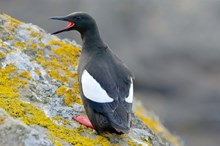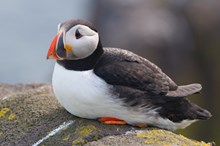18 March, 2016
New report shows promise for puffins in Scotland
After two decades of declining numbers, there are early signs of hope for some seabirds, including common guillemots and puffins. If the trend continues, this could lead to declines slowing and maybe even reversing in some areas.
This is according to the latest seabird indicator for Scotland published by Scottish Natural Heritage (SNH), using information collected from the Seabird Monitoring Programme.
Looking at the number of chicks produced can give an indication of how seabirds have fared in 2014 and 2015. Overall, the number of puffin chicks produced in 2014-15 was slightly higher than the long-term average. Similar results were recorded for some other seabirds, such as herring gull and little tern, although populations are now lower than when results were first collected in 1986.
Although the long-term declines are serious, the 2014-15 results are encouraging. On the Isle of May, the Centre for Ecology & Hydrology (CEH) has been researching the seabirds since 1972. They've found that 2015 was above average for all study species with kittiwakes and shags having a particularly productive breeding season. This was the second consecutive year of high breeding success for kittiwakes after a number of poor years.
Glen Tyler, a marine ornithologist with SNH, said:
“We’re hopeful that the success of puffins and some other seabirds in certain areas of Scotland mean their fortunes are looking up, but it’s really too early to say for sure. There’s continued work to combat some of the pressures on seabirds – for example, by controlling non-native predators. The Scottish Government’s Marine Bill also includes measures to improve marine nature conservation to safeguard and protect Scotland’s unique habitats."
Mark Newell from CEH, who manages long-term seabird research on the Isle of May, added:
“The last few winters have seen a return to slightly cooler winter sea temperatures in the North Sea which is thought to have been beneficial to the development of sandeels, the preferred prey of many of the seabirds. These are encouraging signs as shown by the improved breeding success in the last few years on the Isle of May NNR. However, it is not universally good news as demonstrated by recent winter wrecks of shags and auks.”
The new report follows the latest Birds of Conservation Concern (BoCC) publication in December 2015, which now names puffins, shags, Arctic skua, kittiwakes and herring gulls as red-listed species, indicating an increasing level of conservation concern.
Breeding success varied among the 13 species assessed by SNH. It was higher than the long-term (1986 to 2013) average for seven species: Arctic skua; Atlantic puffin; black-legged kittiwake; common tern; herring gull; little tern; and northern gannet. Three species had lower breeding success than the long-term average: great skua; lesser black-backed gull; and Sandwich tern. Finally, three species had breeding success in 2014 around the long-term average: Arctic tern; common guillemot; and northern fulmar.
The overall numbers of seabirds are still much lower than a couple of decades ago. Some species continue to decline and are struggling in some areas, such as kittiwakes in the Northern Isles. Also affecting seabird populations were the stormy winters before the 1994 and 2005 breeding seasons, which resulted in large ‘wrecks’ along the east coast of Scotland. Another large wreck occurred in winter 2012/13 which affected a number of east coast colonies.
From 1986 to 2014, the mean numbers of 12 species of breeding seabirds in Scotland has declined overall by 38%. The largest declines have been for Arctic skua, declining by 80% from 1986 levels, black-legged kittiwake (71%) and European shag (54%). Black guillemot largely remained stable over the period 1986 to 2014, with recent surveys showing that some sites even have increasing numbers.
Scotland’s seabirds are of international importance. Their numbers may change due to a range of factors including food availability, weather, predation and pollution.
This seabird indicator was prepared using data from the Seabird Monitoring Programme – a partnership project, led and co-ordinated by the Joint Nature Conservation Committee (JNCC) involving a range of conservation partners.
For the full seabird indicator report, see http://www.snh.gov.uk/docs/B424907.pdf . The indicator is part of a suite of biodiversity indicators which are used to assess the state of Scotland’s biodiversity: (http://www.snh.gov.uk/indicators/).
ENDS
Media queries
Contact SNH media officer, Vicki Mowat, on 0131 316 2659 or vicki.mowat@snh.gov.uk (Fri) or the SNH main press office on 01463 725 022.
The Joint Nature Conservation Committee (JNCC) is the statutory adviser to Government on UK and international nature conservation. Its work contributes to maintaining and enriching biological diversity, conserving geological features and sustaining natural systems. JNCC delivers the UK and international responsibilities of the Council for Nature Conservation and the Countryside, the Countryside Council for Wales, Natural England and Scottish Natural Heritage. Visit the website at www.jncc.gov.uk
The Centre for Ecology & Hydrology (CEH) is the UK's Centre of Excellence for integrated research in the land and freshwater ecosystems and their interaction with the atmosphere. CEH is part of the Natural Environment Research Council (NERC), employs more than 450 people at four major sites in England, Scotland and Wales, hosts over 150 PhD students, and has an overall budget of about £35m. CEH tackles complex environmental challenges to deliver practicable solutions so that future generations can benefit from a rich and healthy environment. www.ceh.ac.uk You can follow the latest developments in CEH research via twitter www.twitter.com/CEHScienceNews and our rss news feed http://www.ceh.ac.uk/rss/rss.xml
Contact information
- Name
- SNH Media
- snhmedia@snh.gov.uk
NatureScot is Scotland's nature agency. We work to enhance our natural environment in Scotland and inspire everyone to care more about it. Our priority is a nature-rich future for Scotland and an effective response to the climate emergency. For more information, visit our website at www.nature.scot or follow us on X at https://x.com/NatureScot
’S e NatureScot buidheann nàdair na h-Alba. Bidh sinn a’ neartachadh àrainneachd na h-Alba agus a’ brosnachadh dhaoine gu barrachd suim a chur ann an nàdar. Tha e mar phrìomhachas againn gum bi nàdar na h-Alba beairteach agus gun dèilig sinn gu h-èifeachdach le èiginn na gnàth-shìde. Tha an tuilleadh fiosrachaidh aig www.nature.scot no air X aig https://x.com/NatureScot


